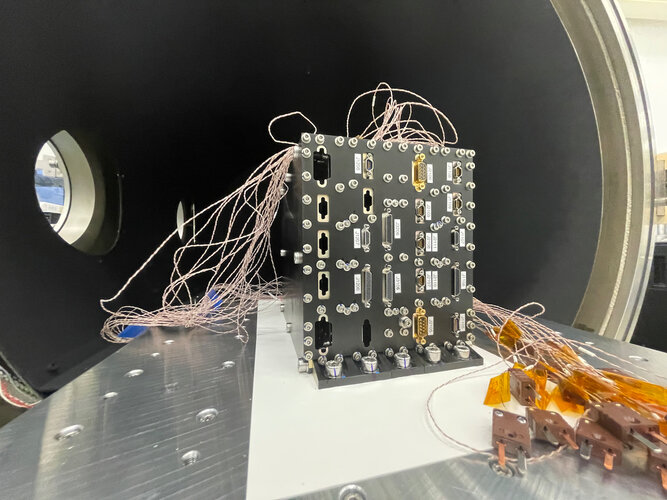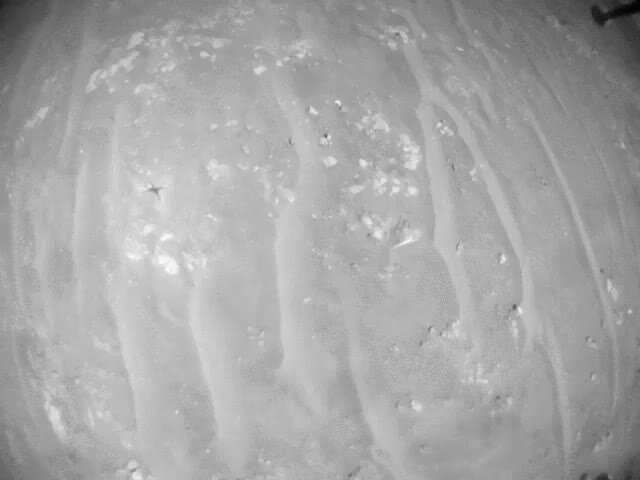
Copernical Team
AFRL sponsorship recipient wins NASA space manufacturing contract
 Air Force Research Laboratory research sponsorship recipient, United Semiconductors, LLC (USLLC), is one of eight companies selected to work on a three-year, $21 million NASA contract to manufacture tools in space.
Almost two decades ago, AFRL's photonic materials branch began collaborating with Professor Partha Dutta at the Rensselaer Polytechnic Institute and sponsoring his research on t
Air Force Research Laboratory research sponsorship recipient, United Semiconductors, LLC (USLLC), is one of eight companies selected to work on a three-year, $21 million NASA contract to manufacture tools in space.
Almost two decades ago, AFRL's photonic materials branch began collaborating with Professor Partha Dutta at the Rensselaer Polytechnic Institute and sponsoring his research on t Vacuum soak for satellite brain
 Image:
Vacuum soak for satellite brain
Image:
Vacuum soak for satellite brain China's space tracking ship departs for 100th mission
OneWeb satellite to be deorbited at the end of its active lifetime
 The world's first mission to remove several small telecommunications satellites from orbit once they reach the end of their operational service is about to start building and testing its prototype spacecraft.
British-based in-orbit servicing company Astroscale - working in an ESA Partnership Project with satellite operator OneWeb - will begin manufacturing the first commercial "servicer" p
The world's first mission to remove several small telecommunications satellites from orbit once they reach the end of their operational service is about to start building and testing its prototype spacecraft.
British-based in-orbit servicing company Astroscale - working in an ESA Partnership Project with satellite operator OneWeb - will begin manufacturing the first commercial "servicer" p Commercial Space Exec: Hands-On Work Can Launch Careers
 Tyler Grinnell ('08) worked at Kennedy Space Center while he was still an Aerospace Engineering student at Embry-Riddle, juggling a full load of classes.
"That was a dream come true for me to be able to work on the space shuttle program while I was just out of my sophomore year," he said, at the university's latest Presidential Speaker Series event.
That real-world experience propell
Tyler Grinnell ('08) worked at Kennedy Space Center while he was still an Aerospace Engineering student at Embry-Riddle, juggling a full load of classes.
"That was a dream come true for me to be able to work on the space shuttle program while I was just out of my sophomore year," he said, at the university's latest Presidential Speaker Series event.
That real-world experience propell New meteor shower? How many meteors will I see, really?
 Astronomers are excited about the possibility of a new meteor shower May 30-31. And that excitement has sparked a lot of information about the tau Herculids. Some has been accurate, and some has not.
We get excited about meteor showers, too! But sometimes events like this don't live up to expectations - it happened with the 2019 Alpha Monocerotid shower, for example. And some astronomers p
Astronomers are excited about the possibility of a new meteor shower May 30-31. And that excitement has sparked a lot of information about the tau Herculids. Some has been accurate, and some has not.
We get excited about meteor showers, too! But sometimes events like this don't live up to expectations - it happened with the 2019 Alpha Monocerotid shower, for example. And some astronomers p Up, Up and Away - Sols 3487-3490
 Our intrepid rover engineers again successfully navigated Curiosity a little higher up Mount Sharp (~5 m) and ~40 m on the ground, away from our previous location. The terrain beneath the rover included striated, dusty bedrock and sand ripples with coarse lag deposits.
As a member of the geology/mineralogy planning team and the APXS payload uplink lead today, I chose several interesting ar
Our intrepid rover engineers again successfully navigated Curiosity a little higher up Mount Sharp (~5 m) and ~40 m on the ground, away from our previous location. The terrain beneath the rover included striated, dusty bedrock and sand ripples with coarse lag deposits.
As a member of the geology/mineralogy planning team and the APXS payload uplink lead today, I chose several interesting ar Why Did Mars Dry Out? New Study Points To Unusual Answers
 Mars once ran red with rivers. The telltale tracks of past rivers, streams and lakes are visible today all over the planet. But about three billion years ago, they all dried up - and no one knows why.
"People have put forward different ideas, but we're not sure what caused the climate to change so dramatically," said University of Chicago geophysical scientist Edwin Kite. "We'd really like
Mars once ran red with rivers. The telltale tracks of past rivers, streams and lakes are visible today all over the planet. But about three billion years ago, they all dried up - and no one knows why.
"People have put forward different ideas, but we're not sure what caused the climate to change so dramatically," said University of Chicago geophysical scientist Edwin Kite. "We'd really like NASA's Ingenuity Mars Helicopter captures video of record flight

Imagery has come down from Mars capturing a recent flight in which the rotorcraft flew farther and faster than ever before.
The Ingenuity Mars Helicopter's black-and-white navigation camera has provided dramatic video of its record-breaking 25th flight, which took place on April 18. Covering a distance of 2,310 feet (704 meters) at a speed of 12 mph (5.5 meters per second), it was the Red Planet rotorcraft's longest and fastest flight to date. (Ingenuity is currently preparing for its 29th flight.)
"For our record-breaking flight, Ingenuity's downward-looking navigation camera provided us with a breathtaking sense of what it would feel like gliding 33 feet above the surface of Mars at 12 miles per hour," said Ingenuity team lead Teddy Tzanetos of NASA's Jet Propulsion Laboratory in Southern California.
The first frame of the video clip begins about one second into the flight. After reaching an altitude of 33 feet (10 meters), the helicopter heads southwest, accelerating to its maximum speed in less than three seconds. The rotorcraft first flies over a group of sand ripples then, about halfway through the video, several rock fields.
Ingenuity Mars Helicopter captures video of record flight
 The Ingenuity Mars Helicopter's black-and-white navigation camera has provided dramatic video of its record-breaking 25th flight, which took place on April 18. Covering a distance of 2,310 feet (704 meters) at a speed of 12 mph (5.5 meters per second), it was the Red Planet rotorcraft's longest and fastest flight to date. (Ingenuity is currently preparing for its 29th flight.)
"For our rec
The Ingenuity Mars Helicopter's black-and-white navigation camera has provided dramatic video of its record-breaking 25th flight, which took place on April 18. Covering a distance of 2,310 feet (704 meters) at a speed of 12 mph (5.5 meters per second), it was the Red Planet rotorcraft's longest and fastest flight to date. (Ingenuity is currently preparing for its 29th flight.)
"For our rec 